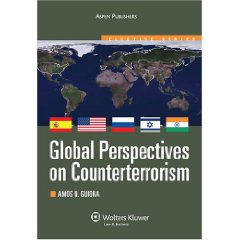|
Reviewed by Willie Curtis, Ph.D., Professor of Political Science at the United States Naval Academy With Global Perspectives on Counterterrorism, Amos N. Guiora has written a timely analysis of the complex issues surrounding the legal and political challenges posed by the global nature of the counterterrorism. In the wake of the violations committed at Abu Ghraib; the concern of a redux of those abuses at the U.S. detention facility at Guantanamo, Cuba; and the perceived objections to the U.S. Patriot Act, many Americans have become increasingly concerned about protecting their constitutional freedoms amid the legal complexities of dealing with counterterrorism issues. Global Perspectives on Counterterrorism provides an excellent analysis using an interdisciplinary approach in which Guiora compares the four aspects of counterterrorism—law, policy, intelligence gathering and operational decision making—from the perspectives of five different countries. His choice of countries is quite interesting in that he chooses to examine the different laws and policies of different governments, suggesting that despite the fact “[d]ifferent regimes have different laws and policies…civil democratic societies also have significant similarities.” (xxiv) Guiora explains that “those similarities and distinctions, in the context of the four subject areas… …are the essence of this book.” (xxiv) Indeed, the comparative analysis of how the five surveyed nations [United States, Israel, Russia, India and Spain] balance legitimate national security interests with equally legitimate rights of the individuals suggests an imbalanced approach in the face of terrorism.” However, Professor Guiora, argues that “Though the dissimilar threats faced mirror the political geographic, historical, and social difference, the responses of the five nations are remarkably similar.” (p.48) The significance of the surveyed nations’ similar responses to different types of threats may raise the eyebrows of a layperson, but Guiora provides ample evidence within the book to back up his assertion. The inclusion of case law, policy documents and case studies from each of the five countries, including seminal court cases that analyze selected case law in each of the five countries, connects their counterterrorism tactics and provides a fresh perspective on the complexity of these timely issues. While similar, there are distinctions to the surveyed countries’ responses examined in this book. Guiora provides a simple chart early in the book that is quite useful in visualizing the differences between the five countries examined regarding the level of judicial review from “High Involvement” in Israel to “Low Involvement” in the United States. One might be concerned that the United States is represented on the low involvement position on the spectrum. This is a most important issue in responding to the threat of terrorism, and Professor Guiora’s contribution regarding this issue is critical. He cautions that “An unfettered executive, unrestrained by courts and legislatures, is detrimental to liberal democracies attempting to balance national security and individual rights.” (p. 73) Indeed, Guiora’s analysis of the importance of judicial review is—in this reviewer’s opinion—the most important contribution of the text. He states, “What separate liberal democratic regimes from dictatorships is the executive’s accountability for its decisions. Whether and how the courts review executive decisions regarding armed conflict is the issue to analyze.” (p. 73) Guiora’s discussion of the views of Aharon Barak, President of the Israel Supreme Court and the late Chief Justice William H. Rehnquist regarding judicial activism in armed conflict is clearly an important contribution to the discussion of the role of the courts during conflicts. For the average American citizen, this book should alert them to the complex issues involved in countering global terrorism are not issues that can be left to a relative small group of policy elites. The stakes are too high and an informed citizenry is essential to retaining our Constitutional liberties. Indeed, as Dr. Craig H. Allen of the University of Washington Law School suggests: “In the tumultuous opening decade of the twenty-first century, the debate over which legal regime should be applied to armed groups leaped from its historical position in the pages of military manuals and academic journals to be front pages of the leading newspapers and cable news services…the legal system and its practitioners have struggles to keep up. There is every reason to believe that the United States is approaching a tipping point on the matter, and will soon be compelled to give the legal regime as much attention as has been given to strategies and policies for responding to the threats.” (Craig H. Allen, “Armed Groups and the Law,” Armed Groups: Studies in National Security, Counterterrorism, and Counterinsurgency, edited by Jeffrey H. Norwitz, (Rhode Island: U.S. Naval War College, 2008) How current and future administrations handle the collision of necessary threat deterrence and protections afforded citizens under the Constitution will help dictate the future of the U.S. strategy to combat terrorism. To that end, Guiora’s book, Global Perspectives on Counterterrorism has contributed to the task of providing an excellent text for use at colleges, universities, military academies and a must read for policy makers and legal scholars. |


 Global Perspectives on Counterterrorism
Global Perspectives on Counterterrorism